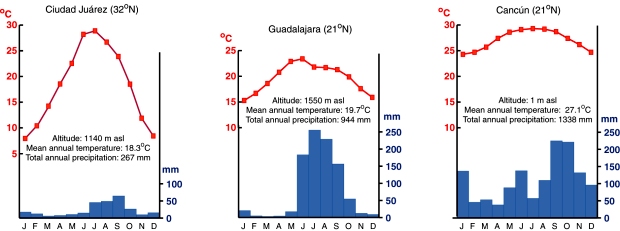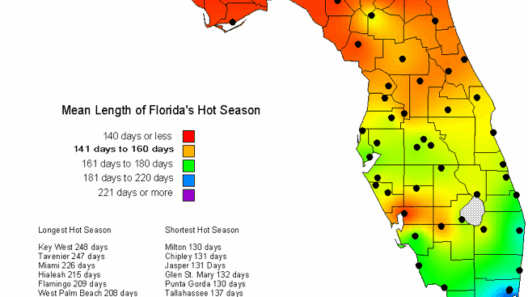Mexico, a vibrant tapestry woven from diverse cultures and breathtaking landscapes, also boasts a remarkable array of climates that vary dramatically across its regions. Understanding this climatic kaleidoscope is essential for grasping the ecological and cultural richness of the country. Each region’s climate not only shapes its natural environment but also influences the way of life, agricultural practices, and economic opportunities.
To embark on this journey, let us traverse the Mexican landscape, exploring its distinct climatic regions: the arid deserts of the North, the temperate central highlands, the tropical coasts, and the lush southern jungles.
1. The Northern Deserts: A Parched Expanse
The northern regions of Mexico, spanning states such as Chihuahua and Sonora, are characterized by an arid desert climate. Here, the sun reigns supreme, orchestrating a relentless symphony of heat and dryness. In this expanse, the rainfall is a scarce commodity, averaging a mere 10 to 20 inches per year. The climate is marked by sweltering summers, where temperatures can soar above 100°F (38°C), juxtaposed with frigid winters that plunge near freezing.
Yet, life flourishes in this seemingly inhospitable environment. The resilient flora and fauna, such as the iconic saguaro cactus and the roadrunner, symbolize endurance amid adversity. This region serves as a reminder of nature’s remarkable adaptability, inviting us to ponder the intricate balance required to thrive in extreme conditions.
2. The Central Highlands: A Temperate Oasis
As we ascend into the heart of the country, the central highlands emerge, cradling Mexico City and other significant urban centers. This region enjoys a temperate climate, with distinct wet and dry seasons. Temperatures generally range from 50°F (10°C) to 80°F (27°C), creating an inviting atmosphere for agriculture and urban development.
The rainy season, which unfolds between June and September, bestows vital nourishment upon the land, transforming arid hillsides into verdant landscapes blooming with corn, beans, and a myriad of other crops. The rich agricultural heritage in this region highlights the synergy between climate and culture, as local cuisines, festivals, and lifestyles integrate the bounty of the land.
In this temperate oasis, diverse ecosystems flourish, including pine forests and grasslands, teeming with wildlife. The milder climate attracts an array of migratory birds, filling the skies with song and color, a veritable celebration of life against a backdrop of dramatic mountains.
3. The Tropical Coasts: A Sultry Embrace
Transitioning from the highlands, the coastal regions of the Yucatan Peninsula and the Pacific coast reveal a striking contrast: a tropical climate that exudes warmth and humidity. This sultry embrace evokes images of swaying palm trees, turquoise waters, and vibrant sunsets. The coastal areas experience high temperatures year-round, averaging between 70°F (21°C) and 90°F (32°C), ensuring that beachgoers bask in sun-soaked splendor.
Rainfall, abundant yet capricious, defines the tropical season, which typically spans from May to October. During this period, storms are common, as the region becomes a canvas for dramatic weather patterns. Hurricanes, though infrequent, pose a formidable threat, reminding coastal inhabitants of the raw power of nature.
Intriguingly, the tropical climate nurtures a distinctive ecosystem teeming with biodiversity. The lush mangroves and coral reefs foster a vibrant aquatic life, while terrestrial jungles shelter myriad species, making this region a hotspot for ecotourism. The tropics resonate with the rhythms of life, emphasizing the interconnectedness of humans and nature.
4. The Southern Jungles: A Lush Enclave
Venturing farther south, one discovers the jungles of Chiapas and Veracruz, where a humid subtropical and tropical climate prevails. This region is a veritable embrace of greenery, with dense forests that form a complex web of life. The climate is warm and wet, with temperatures exceeding 80°F (27°C) and humidity levels that can make the air feel thick and heavy.
Rainfall is plentiful here, often exceeding 80 inches (204 cm) annually. The rainy season stretches from late spring to early autumn, drawing forth a spectacular display of flora. Orchids, vines, and towering trees create a lush canopy that supports countless wildlife species, from colorful birds to elusive jaguars. The biodiversity found in these jungles underscores the importance of conservation efforts, as they house invaluable ecosystems at risk from climate change and human activity.
Moreover, the indigenous cultures of this region possess a profound connection to the land, utilizing the abundant natural resources sustainably. Their traditional practices are a testament to harmonious living, emphasizing the need for a renewed respect for the environment in an age of rapid urbanization and environmental degradation.
Conclusion: The Climate Mosaic
Mexico’s climate is a rich mosaic, intricately stitched together by diverse regional characteristics that invite exploration and understanding. From the arid expanses of the deserts to the lush jungles, each climate informs not only the environmental landscape but also the cultural identity of its people. This climatic diversity offers numerous opportunities for ecological preservation and sustainable practices, urging us to consider how we, too, can embrace our environment with reverence and stewardship.
As the effects of climate change loom large, recognizing the uniqueness of Mexico’s climates becomes all the more crucial. By fostering a deeper appreciation for these climatic identities, individuals and communities can unite in efforts to safeguard the future of such a vibrant and diverse nation.





